What s Cooking in Google Labs Today
What's Cooking in Google Labs TodayAt any given point in time, Google Labs has a dozen or so new projects percolating on the virtual test bench. Some of these projects will graduate into normal distribution; others will be incorporated into other products; and there will always be a few that just don't cut it and eventually wither away. With that in mind, let's take a quick look at what's currently being tested in Google labs. Google TrendsGoogle Trends (www.google.com/trends) builds on the top searches compiled in the Google Zeitgeist to form a huge database of user information. Using a variety of data mining and analysis techniques, Google Trends lets you sort through search query data to determine the popularity of a given topic over time. Note The researchers at Google Labs are always working on new projects, so the projects available when you're reading this book may be different from the projects listed here. For example, Figure 42.1 shows a trend analysis of the search query Angelina Jolie. As you can see, Angelina's popularity continues to trend upwards over time, with some obvious peaks coinciding with various news stories. At the bottom of the page is a list of the top cities that searched for this topic; it appears that the folks in Irvine, California, really like Ms. Jolie. Figure 42.1. A Google Trends of Angelina Jolie. Tip The Google Zeitgeist (www.google.com/press/zeitgeist.html) presents the top search queries entered by Google users on a weekly, monthly, and yearly basis. For example, the top five searches in 2005 were, in order, Janet Jackson, Hurricane Katrina, tsunami, xbox 360, and Brad Pitt. When it officially launched Google Trends, the company pointed out that the service could be quite useful for its Google AdSense advertisers. Advertisers can use the Google Trends service to examine product trends over timeas well as trends in different regions. It's just one more clue that points to Google's core business being advertising, rather than technology. Google Co-opGoogle Co-op (www.google.com/coop) is an experiment in user participation. Google is pushing Google Co-op as a way for Google users to improve Google search by letting users label web pages and create specialized links related to their own unique expertise. Note If you're a developer, you can use the Google Subscribed Links API to add your services directly into Google search. For example, if you're an expert at a particular hobby, like digital photography, you can help categorize the digital photography pages you visit by giving them specific labelsReviews, Sample Photos, Price Comparisons, Troubleshooting, and so on. When other users search Google Co-op for digital photography topics, they can then filter their results based on the user-created labels. Another aspect of Google Co-op is the subscribed link. This is, essentially, a hard-wired sponsored link for related services that will appear at the top of relevant search results. I'm not sure how valuable this really is to users; most of the subscribed links I've seen so far are just glorified advertisements. To that end, most of the contributors to Google Co-op (so far, at least) appear to be large companies with content to sell. For example, the Destination Guides category is heavily populated by Fodors, Frommer's Lonely Planet, and other commercial travel guide publishers, as you can see in Figure 42.2. Now, their contributions may be valuable, but it's a far cry from the user-populated co-op that Google promised. Figure 42.2. The Destination Guides category of Google Co-op.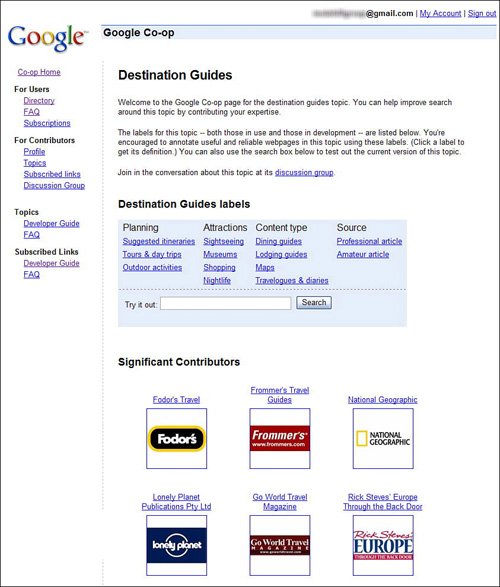 Google NotebookGoogle Notebook (www.google.com/notebook) is a web-based (or, alternatively, a browser-based) tool that lets you create an online "notebook" to organize all your web-based research on a given topic. You clip text, images, and links from interesting pages you visit, storing them in a topic-specific notebook page, like the one in Figure 42.3. It's a great way to organize typically chaotic web-based research activities. Figure 42.3. Organizing notes and web links in a Google Notebook.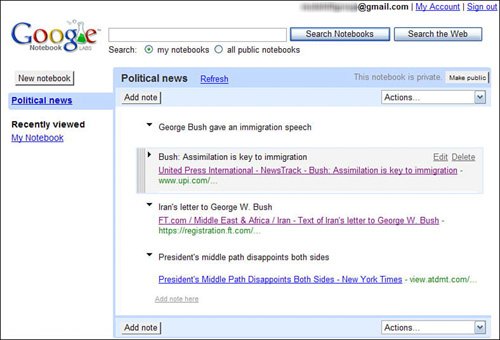 The browser-based part of Google Notebook, by the way, comes in the form of a Google Notebook button that installs on an Internet Explorer toolbar. Click the button to display a list of Notebook-related actions, including saving a link to the current web page in a given Notebook. Google ReaderNote Learn more about Google Reader in Chapter 6, "Searching Blogs and Blog Postings." As discussed previously in this book, Google Reader (www.google.com/reader) is a web-based RSS/Atom feed aggregator. Use Google Reader, shown in Figure 42.4, to automatically display the latest articles and headlines from blogs and websites that offer RSS and Atom feeds. Figure 42.4. The Google Reader feed aggregator.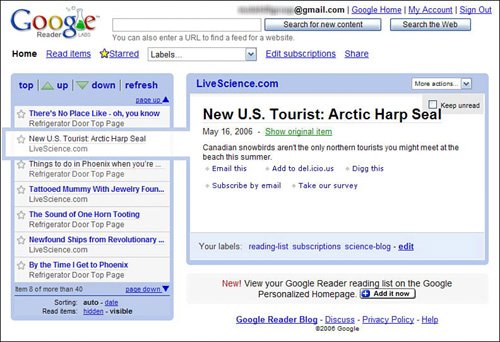 Google Related LinksGoogle Links (www.google.com/relatedlinks) is a way to put related links on your own web page. Insert the proper HTML code, and Google places a box of topic links on your page. As you can see in Figure 42.5, these links are organized by Searches, News, and Web Pages; when site visitors click these links, they see a page of related Google news or search results. Figure 42.5. Add Google Related links to your web pages. Note Learn more about Google Sets in Chapter 9, "Searching for Words and Definitions." Google SetsWe also discussed Google Sets (labs.google.com/sets) earlier in this book. The concept here is to enter a few words that make up a type of list, and then let Google try to predict other items in the list. Figure 42.6 shows Google Sets at work. Figure 42.6. Filling in the blanks with Google Sets. Google Page CreatorHere's a neat new tool that's definitely ready for prime time. When you want to create your own personal web page, you can turn to one of the many free web hosting communities (such as Yahoo! Geocities) or you can pay an expensive web hosting service. However, now you can use the recently launched Google Page Creator, a web-based tool that helps you create your own web pagesand then hosts those pages on Google's very own web page hosting community. As you can see in Figure 42.7, Google Page Creator (pages.google.com) lets you create your web pages in a WYSIWYG environment. Just enter your page title, text, and pictures, and then click the Change Look and Change Layout links to customize the look and feel of your page. When you're done, click the Publish button and your website is published with its own unique URL, in the form of yourname.googlepages.com. Both the page creation and hosting are completely free. Figure 42.7. Creating your own web page with Google Page Creator.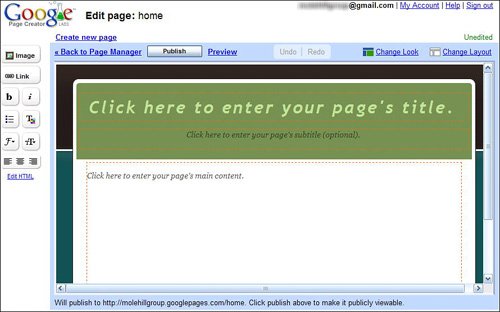 Google MarsIf you like Google Maps and have an eye for the stars, you'll love Google Mars. As you can see in Figure 42.8, Google Mars (www.google.com/mars) is essentially Google Maps for the red planet, using detailed Martian maps, as supplied by NASA. Figure 42.8. Navigate the Martian terrain with Google Mars. Google Ride FinderGoogle Ride Finder (labs.google.com/ridefinder) is a Google Maps mashup that lets you view the locations of taxis, shuttles, and limousines. Google Rider Finder contains real-time information for 15 major citiesAtlanta, Baltimore, Chicago, Dallas, Houston, Los Angeles, New York, Phoenix, Portland, San Francisco, San Jose, Seattle, St. Louis, Tucson, and Washington, DC. (Figure 42.9 shows the location of taxis in Chicago.) Figure 42.9. Google Ride Finder for Chicago.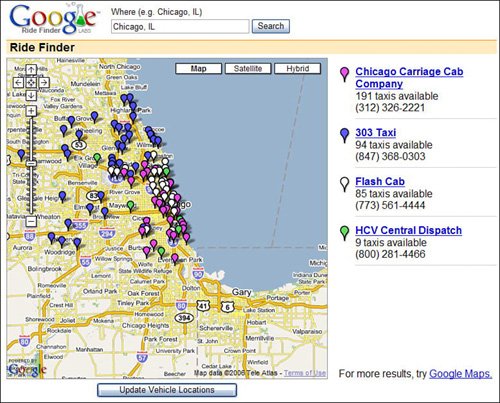 Google TransitGoogle Transit (www.google.com/transit) is another Google Maps mashup that lets you plan trips using public transportation. At present, it's only enabled for the Portland, Oregon area. Froogle for MobileFroogle for Mobile (labs.google.com/frooglewml.html) lets you do comparison shopping in the real world. Just whip out your mobile phone when you're in a store, and query Froogle for Mobile to see if the current price is a good one. Google SuggestGoogle Suggest (www.google.com/webhp?complete=1&hl=en) is a technology that offers keyword suggestions as you enter a Google search query. At present, Google Suggest is included as part of the new Google Toolbar and Google Desktop search. Google Dashboard Widgets for MacIf you like the gadgets in Google Desktop but currently use a Macintosh computer, you're in luck. Google Dashboard Widgets for Mac (www.google.com/macwidgets/) translates several popular Google Desktop sidebar gadgets into widgets for the Apple Dashboard. Google Extensions for FirefoxNote Google also offers Google Suggest in Japanese (www.google.co.jp/webhp?complete=1&hl=ja). If you're using Mozilla Firefox instead of Internet Explorer as your web browser, Google Extensions for Firefox (www.google.com/tools/firefox) lets you add a variety of browser extensions to provide new functionality. Google Web AcceleratorGoogle Web Accelerator (webaccelerator.google.com) is a technology that speeds up your web browsing by preloading popular web pages. It's free, and works on both dial-up and broadband connections. Google SpreadsheetsThe latest, greatest application from Google Labs is Google Spreadsheets (spreadsheets.google.com), a web-based spreadsheet application that mimics some of the key features of freestanding spreadsheets, such as Microsoft Excel. As you can see in Figure 42.10, the basic interface looks pretty much like every other spreadsheet you've ever seen. You can enter numbers, words, formulas, functions, you name it, into any cell, and then format each cell as you like. (Functions are available by clicking the More link at the top right of the spreadsheet.) And, as with Excel, you can have multiple sheets in each spreadsheet. Sheets are selected from the tabs at the bottom of the main page. Figure 42.10. Google Spreadsheetsa full-function web-based spreadsheet application.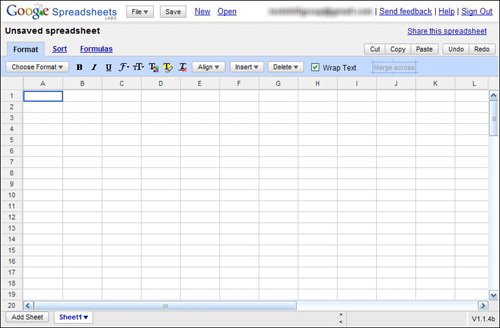 What's unique about Google Spreadsheets is that it's all web-based. The application and all your spreadsheets reside on Google's server, not on your computer. One nice thing about this is that your spreadsheets can be accessed wherever you are, from any PC; you'll never discover that the spreadsheet you need is located on your office PC when you're at home or away. The other nice thing is that, by being web-based, you can share your spreadsheets with others. That makes workgroup collaboration possible, which is something you don't have with Excel and other spreadsheet programs. Note To learn more about how to use Google Spreadsheets, check out my latest e-Book, Using Google Spreadsheets. You can purchase and download it at www.quepublishing.com/title/0768668336. The other thing that's unique about Google Spreadsheets is that it's free. That's free, as in it costs zero dollars, unlike the increasingly more expensive Microsoft Excel. Being free makes it easy to take for a test drive, and even easier to add to your bag of applications. Many early users who've tried Google Spreadsheets have said that they're likely to switch from Excel; it can do almost everything Excel can do, from a numbers standpoint (there aren't any charts and graphs as yet), and it's perfect for corporate and small business environments. Give it a try! |
EAN: 2147483647
Pages: 370
